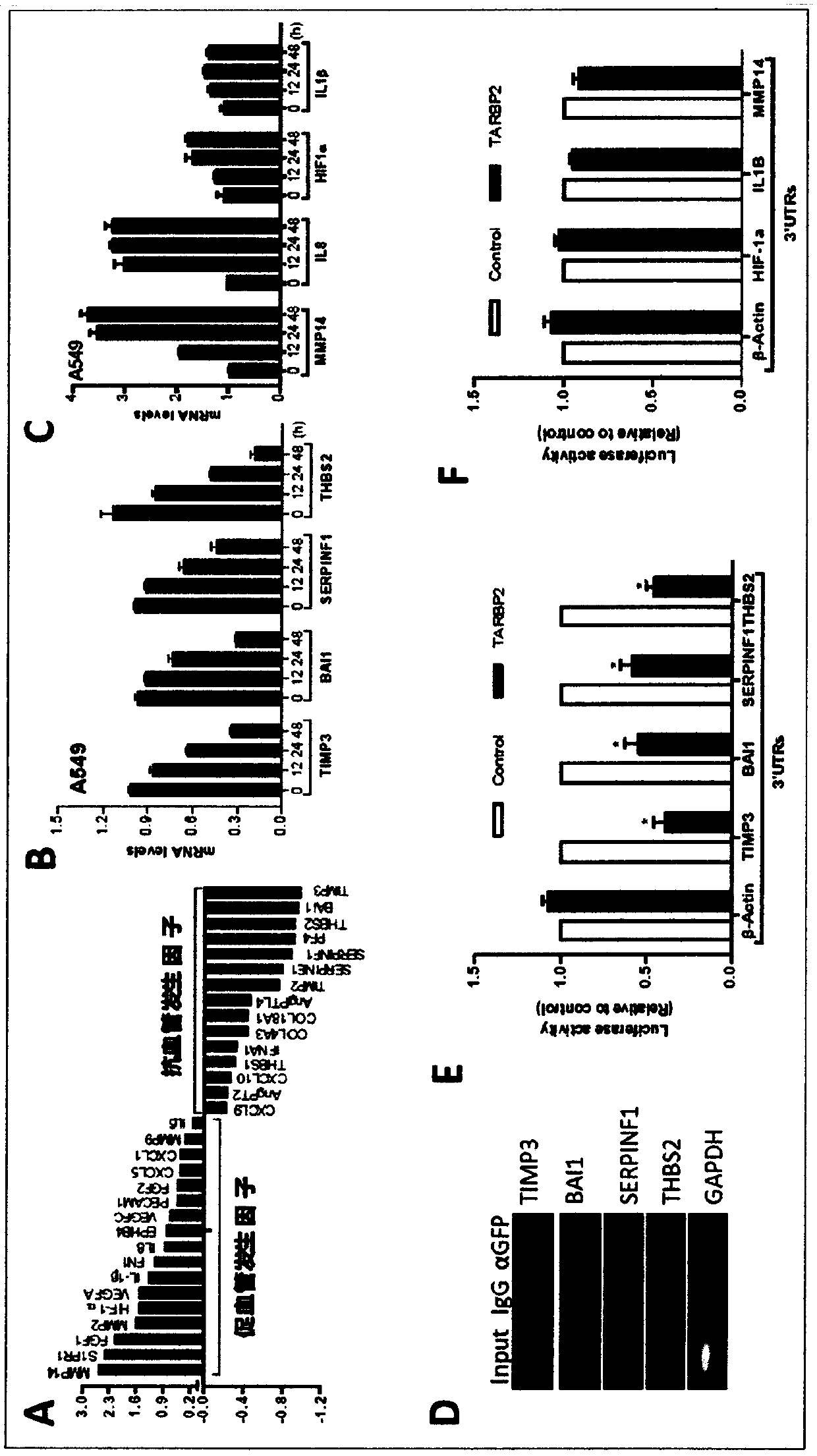Tumor angiogenesis regulatory protein TARBP2, and encoding gene and application thereof
A technology of tumor blood vessels and regulatory proteins, applied in the field of genetic engineering, can solve problems such as the unclear role and mechanism of TARBP2, and achieve the effect of inhibiting tumor angiogenesis and promoting tumor metastasis
- Summary
- Abstract
- Description
- Claims
- Application Information
AI Technical Summary
Problems solved by technology
Method used
Image
Examples
Embodiment 1
[0029] Example 1: Identification of a novel function of TARBP2 in controlling tumor angiogenesis
[0030] The human TARBP2 gene (NM_134324.2) was synthesized by gene synthesis method and cloned into pEGFP-N1 eukaryotic expression vector after complete sequencing. A549 cell clones (A549 / TARBP2) and MDA-MB-468 cell clones (MDA-MB-468 / TARBP2) stably expressing TARBP2 were produced by G418 screening, and the protein expression results were as follows figure 1 A and 1B are shown. The control group and TARBP2-overexpressing tumor cells were cultured for 48 hours to collect the conditioned culture supernatant (CM), centrifuged at 2000g at 4°C for 10 minutes to remove cell debris, and aliquoted for use. After the HUVECs were cultured to confluence, they were replaced with 2% FBS growth factor-free medium. Use a 200uL pipette tip to scratch the endothelial cell monolayer and add tumor cell CM. Photographs were taken at the beginning of culture and after 24 hours. The percentage of ...
Embodiment 2
[0031] Example 2: Functional identification of TARBP2 specific degradation of anti-angiogenic factor mRNAs
[0032] 1) In order to further detect how TARBP2 regulates tumor angiogenesis, genes related to its regulation of tumor angiogenesis signaling pathways were detected. Pro-angiogenic factor mRNAs were upregulated after TARBP2 overexpression, while anti-angiogenic factors were downregulated. RNA-IP experiments further confirmed that TARBP2 can target and bind anti-angiogenic factors. Moreover, luciferase reporter experiments also confirmed that TARBP2 can target the 3'UTRs of anti-angiogenic factor mRNAs to degrade their mRNAs, but cannot target the 3'UTRs of pro-angiogenic factor gene mRNAs. In-depth examination of the half-life of anti-angiogenic factor mRNAs found that TARBP2 significantly reduced their half-life, but did not affect the half-life of pro-angiogenic factor gene mRNAs. This further confirms that TARBP2 specifically degrades mRNAs of anti-angiogenic facto...
Embodiment 3
[0035] Example 3: Treatment of Tumor Metastasis by Targeted Knockdown of TARBP2 Gene and Protein
[0036] In order to detect the role of targeted knockdown of TARBP2 gene in inhibiting tumor angiogenesis and tumor metastasis, firstly, lentiviruses expressing shRNAs targeting TARBP2 gene were used to infect tumor cells in vitro, and the effect of anti-angiogenesis after knockdown of TARBP2 protein expression was detected. Factor mRNAs expression and its half-life. Knockdown of TARBP2 was found to significantly increase the expression of anti-angiogenic factors and increase the half-life of their mRNAs. In vivo, using adenoviral vectors expressing shRNAs targeting the TARBP2 gene to simulate clinical treatment of tumor-bearing nude mice, it was found that the number of blood vessels in the treated tumor tissue was significantly reduced, and the lung tumor metastasis of the mice was also significantly reduced. In summary, the experimental results showed that targeted knockdown o...
PUM
 Login to View More
Login to View More Abstract
Description
Claims
Application Information
 Login to View More
Login to View More - R&D
- Intellectual Property
- Life Sciences
- Materials
- Tech Scout
- Unparalleled Data Quality
- Higher Quality Content
- 60% Fewer Hallucinations
Browse by: Latest US Patents, China's latest patents, Technical Efficacy Thesaurus, Application Domain, Technology Topic, Popular Technical Reports.
© 2025 PatSnap. All rights reserved.Legal|Privacy policy|Modern Slavery Act Transparency Statement|Sitemap|About US| Contact US: help@patsnap.com



